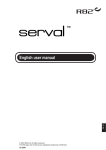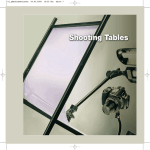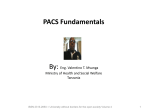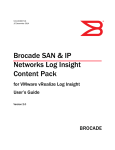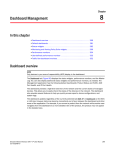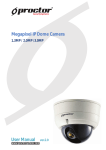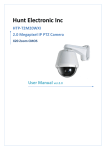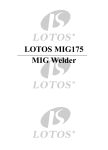Download ALW Push Pull Gun PPG 300 Instruction Manual
Transcript
ALW Push Pull Gun PPG 300 Instruction Manual Contents 1. 2. 3. 4. 5. General Technical Data Safety Warnings Liner Installation Installing the ALE-PPG300 Troubleshooting 1. General Technical Data Ambient Temperature - when welding -10oC to +40oC - during shipping and storage -25oC to +55oC Relative air humidity up to 90% at 20oC Type of cooling Air Duty Cycle 60% Rating (CO2) 290 A (Argon/ CO2 mixes) 260 A When pulse arc welding reduce the amperage rating by 30% Wire diameter 0.6 – 1.2 mm Gas flow rate 10 – 20 lpm 2. Safety Warnings When using this welding torch be aware of the relevant safety requirements: Only operators with the relevant knowledge of arc welding equipment should use the system. Arc welding can cause damage to eyes, skin and hearing. Therefore, always wear the required safety clothing, eye and ear protection in compliance with the relevant regulations. The amperage rating represents maximum values. Overloading can lead to torch damage or destruction. Before cleaning and replacing consumables, switch off the power supply. Following the operating instructions for the individual welding components, e.g. the power supply. Do not pull the cable assembly across sharp edges or set it down in the welding spatter area or on hot work pieces. Use curtains or partitions to protect those not involved in the welding process from radiation and the danger of arc flashing. When handling gas cylinders, consult the instructions from the manufacturers and suppliers of compressed gas. Work pieces, which have been degreased with chlorinated solvents, must be thoroughly cleaned before welding starts to avoid the risk of phosgene gas forming. For the same reason, no degreasing baths containing chlorine must be placed in the vicinity of the welding area. Observe fire hazards caused from spatter / drops created during welding. During welding work, remove everything combustible from the working area. During welding work in confined spaces, electrical hazards increase. Protect yourself accordingly through use of insulating mats, dry clothing and sufficient ventilation and exhaust. Fumes produced when welding, especially lead, cadmium, copper, zinc, and beryllium are harmful. Use ventilation or an extraction system to ensure that specified MAC values are not exceeded. Place appropriate fire extinguishing equipment in the workplace, within easy reach. ALW Push Pull Gun PPG 300 Instruction Manual 3. Liner Installation Lay the torch out straight and remove the liner-retaining nut at the wire-feed end of the torch cable. Remove the existing gun liner if fitted. Sharpen the end of the plastic liner with a knife or pencil sharpener. Gently feed the Teflon liner through the cable assembly until the liner bottoms out in the torch body. Insert the collet, the o-ring and the union nut onto the plastic liner, keeping these under tension and tighten the union nut. Guide the central plug with the extra long plastic liner into the wire-feeding unit. Mark the plastic liner directly before the drive rolls and loosen the union nut again. Cut the plastic liner off at the mark. Sharpen the exposed end of the liner. 4. Installing the ALW-PPG300 Place the control box on top of the power supply. Unroll the gun and place front end away from the machine. Insert the back end of the gun into the wire feeder connection. Push in tight and tighten the adapter nut. Plug the two connectors attached to the back end of the gun into the control box – one is a 4-pin the other is a 5-pin connector. Plug the control box into a 110 V outlet. Check to make sure the drive rolls match the wire size. Loosen off the feeders drive rolls and gently hand feed about 20 cm (7.8 in) of wire into the liner at back of the welding gun. Close the drive rolls and set the tension as close to zero as possible. Remove the drive-roll cap on the gun (pull it straight up) and check that the drive roll matches the wire size. Replace the drive-roll cap. Remove the front-end consumables (nozzle, contact tip, tip holder and insulator). Turn on the power supply, press the trigger on the gun and feed the wire at a slow speed until the wire emerges from the front end. Re-install the consumables. Turn on the gas supply. ALW Push Pull Gun PPG 300 Instruction Manual 5. Troubleshooting TROUBLESHOOTING: POROSITY (SUMMARY) Causes of Porosity BASE METAL CONTAMINATION Impurities on base metal FILLER METAL CONTAMINATION Impurities on filler metal (wire) ATMOSPHERIC CONTAMINATION Drafts, wind, fans, etc. GAS MIXING APPARATUS 1. Too high a gas flow, causing turbulence, and/or sucking air at hose connections; creating venturi effect at end of gas nozzle. 2. Too low a gas flow, causing insufficient gas coverage. 3. Damaged or kinked gas lines. 4. Too high of an oxygen content. 5. Leaks in gas distribution system. 6. Other impurities in gas – moisture, etc. 3 7. Inconsistent gas flow (m /h - cfh) at the torch connection. WELDING PARAMETERS, ETC. 1. Too long a wire stick-out; gas nozzle too far from weld puddle. 2. Bad torch position – too sharp a torch incline causing venturi effect at the end of the nozzle leading to atmospheric contamination. 3. Excessively wide weld pool for nozzle I.D. 4. Arc voltage too high. 5. Too high a travel speed. Possible Solutions a. Remove contamination; clean surfaces. b. Use of specific wire/gas mix for specific types of impurities. a. Replace wire. b. Install wire-cleaning system. c. Prevent industrial dust/dirt/grit from contaminating wire during storage or use. d. Prevent build-up of aluminum oxide on exposed aluminum wire surface by using up quickly. e. Remove wire from wire drive unit and store in a sealed plastic bag when not in use for long periods. a. Protect weld from drafts (curtains/screens). b. Use tapered or bottlenecked gas nozzles when drafts cannot be avoided. 1a. Reduce gas flow. 1b. Tighten all hose connection points. 2. Increase gas flow. 3. Repair or replace 4. Adjust mixer. 5. Repair leaks. 6. Overhaul system; fit filters and/or dryers. 3 7. Regulate pressure into flowmeter for consistent (m /h – cfh) delivery of gas. 1. Use longer nozzle or adjust stick-out (3/8” or 10 mm minimum or 15 times wire diameter). 2. Correct torch angle. 3. Width of the weld pool should be 1.3 times nozzle I.D.; use suitable wider gas nozzle. 4. Reduce voltage. 5. Reduce speed. Note: Most POROSITY is caused by gas problems, followed by base metal contamination ALW Push Pull Gun PPG 300 Instruction Manual TROUBLESHOOTING: GENERAL GUIDE Problems/Causes ERRATIC WIRE FEED Slipping feed rolls. Clogged or worn gun liner. Liners too long or too short. Spatter on wire. Coil brake incorrectly adjusted. UNSTABLE ARC Incorrect setting of voltage and/or current. Problems in wire feeding. Worn contact tip. Impurities on the base metal. Poor contact between ground cable and workpiece. Loose power connection Stick-out too long. Possible Solutions Check that the feed-roll size is correct for the wire size being used. Increase the drive-roll pressure until the wire feed is even. Do not apply excessive pressure as this can damage the wire surface, causing copper coating to loosen from steel wires or metal shavings to be formed from soft wires like aluminum. These metal fragments or shavings can be drawn into the wire-feed conduit and will rapidly clog the gun liner. When welding with flux-cored wires, excessive drive-roll pressure may open the wire seam and allow flux or metal powders to escape. a. Dust, particles of copper, drawing lubricants, metal or flux and other forms of contamination can all clog the gun liner so that the wire feed is slowed or impeded. A liner that has been in use for an extended period of time becomes worn and filled with dirt and must be replaced. b. When changing the welding wire, remove the swanneck from the front end of the gun and blow out the gun liner with clean, dry compressed air from the back of the gun. Repeat with the neck liner. Note: Wear safety goggles when using compressed air to clean the liners. Make sure proper safety procedures are followed in order to avoid possible serious eye injury. Check the lengths of the neck and gun liners and trim or replace if too long or too short. The efficient feeding of the welding wire depends on correct liner fittings. Consult the liner installation instructions or contact Air Liquide. An unprotected coil of wire quickly collects dust and other airborne contamination. If grinding is being performed in the vicinity, particles can become attached to the wire, severely interfering with the wire feed. Replace with clean wire and keep it protected with a cover. Make sure spare wire rolls are stored in a clean, dry place. Set the brake so that the coil immediately stops rotating as soon as welding is interrupted. If the brake is applied too hard it will cause the feed rolls to slip, resulting in uneven wire feed. If it is too loose, overrun of the wire will occur, causing wire tangles, inconsistent tension on the feed mechanism and irregular arc characteristics. Set the wire feed in relation to the arc voltage in such a way that the arc is stable and burns evenly. In spray arc welding, set the wire feed so that there are no short circuits and the filler metal is transferred in a spray across the arc. Find the cause of the interference and correct it. (See above) When the internal diameter of the contact tip becomes worn from the passage of wire through it, the wire may no longer stay in continuous electrical contact with the tip. This results in an unstable arc and an increase in spatter. Paint, mill scale, silicon scale, rust or flux deposits from previous weld runs may form an insulating layer causing an unstable arc. Clean the surfaces to be welded. Securely attach the ground cable as close to the point of welding as possible on the workpiece. Clean surfaces thoroughly to ensure good contact. Check to insure the welding power connection on the power source is tight, the connection on the wire feeder is tight, the connection to the adaptor block is tight, and the connection of the gun to the adaptor block is tight Adjust the contact tip to work distance to a minimum of 3/8” (10 mm) for shortarc welding. A more precise distance is 15 times wire diameter. ALW Push Pull Gun PPG 300 Instruction Manual TROUBLESHOOTING: GENERAL GUIDE Problems/Causes SPATTER Too fast or too slow wire feed for the arc voltage. Too long an arc. Damaged contact tip. Inclination of welding gun too great. Faulty power source. Incorrect start. Incorrect pulse parameters. Uneven wire feed. Impurities on the base metal. Poor ground contact. Too long stick-out (short-arc welding). Incorrect polarity. Possible Solutions Set the wire-feed rate and voltage in accordance with good welding practices as recommended by a qualified welding engineer. Adjust the wire feed and voltage so that the arc is in accordance with good welding practice for the joint to be welded. The distance from the contact tip to the workpiece should be 15 times the welding wire diameter. If the arc is too long there will be spatter, usually in the direction of the weld. If the contact tip becomes worn, the welding wire will not be in constant contact with the tip and the arc will become unstable. A contact tip contaminated with spatter will cause uneven wire feed resulting in further spatter. The angle of the gas nozzle relative to the workpiece should be between 45 to 90 degrees. If the angle is too small, the wire runs parallel to the weld pool, resulting in spatter in the direction of welding. Have the power source checked for faulty conditions such as broken wires and faulty contacts. A great deal of spatter occurs if the stick-out is too great and if the welding gun is held too far from the workpiece when striking the arc. Try to start with as short a stick-out as possible and with the welding gun as close to the starting point as possible. If a large ball end is formed on the end of the welding wire, remove it by cutting the wire with sharp wire cutters. It is helpful if the wire is cut to a point always remove the ball end before striking an aluminum arc. Check the welding ground connection. Check the user manual for your power supply or consult a qualified welding engineer. Uneven wire feed gives rise to heavy spatter. Find the cause of the disturbance and correct the condition before proceeding. Paint, mill scale, rust and other contamination on the base metal form an insulating layer causing an unstable arc that results in heavy spatter. Clean the surfaces to be welded. Inspect ground cable for loose connections, fraying and cuts. Correct any problem areas found and attach the ground cable directly to the workpiece after having cleaned the contact surface first. POOR GROUND CONTACT IS THE MOST COMMON CAUSE OF UNSTABLE MIG WELDING CONDITIONS. The stick-out should be 15 times the diameter of the wire electrode being used. With increasing stick-out, the current is reduced and the arc voltage rises, giving a longer unstable arc and increased spatter. Check for correct polarity. Follow the electrode manufacturer’s recommendations.







